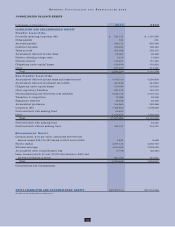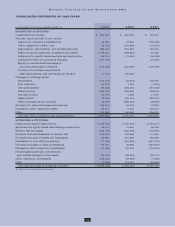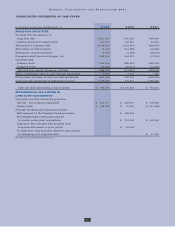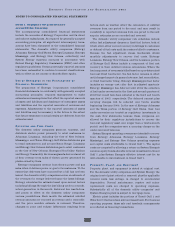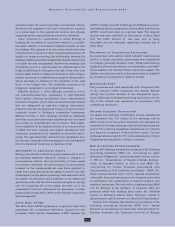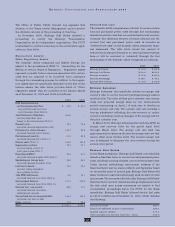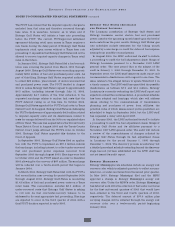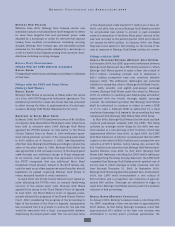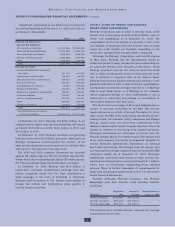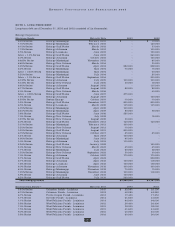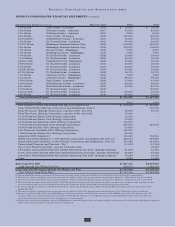Entergy 2003 Annual Report Download - page 63
Download and view the complete annual report
Please find page 63 of the 2003 Entergy annual report below. You can navigate through the pages in the report by either clicking on the pages listed below, or by using the keyword search tool below to find specific information within the annual report.
61
ENTERGY CORPORATION AND SUBSIDIARIES 2003
exempted under the normal purchase, normal sales criteria.
Revenues and expenses from these contracts are reported
on a gross basis in the appropriate revenue and expense
categories as the commodities are received or delivered.
Other contracts for commodities in which Entergy is
hedging the variability of cash flows related to a variable-
rate asset, liability, or forecasted transaction qualify as cash
flow hedges. The changes in the fair value of such derivative
instruments are reported in other comprehensive income. To
qualify for hedge accounting, the relationship between the
hedging instrument and the hedged item must be documented
to include the risk management objective and strategy, and
at inception and on a ongoing basis the effectiveness of the
hedge in offsetting the changes in the cash flows of the item
being hedged. Gains or losses accumulated in other compre-
hensive income are reclassified as earnings in the periods in
which earnings are affected by the variability of the cash
flows of the hedged item. The ineffective portions of all
hedges are recognized in current-period earnings.
Effective January 1, 2001, Entergy recorded a net-of-
tax cumulative-effect-type adjustment of approximately
$18.0 million reducing accumulated other comprehensive
income to recognize, at fair value, all derivative instruments
that are designated as cash-flow hedging instruments,
primarily interest rate swaps and foreign currency forward
contracts related to Entergy’s competitive businesses.
Effective October 1, 2001, Entergy recorded an additional
net-of-tax cumulative-effect-type adjustment that increased
net income by approximately $23.5 million. This adjust-
ment resulted from the implementation of an interpretation
of SFAS 133 that requires fuel supply agreements with
volumetric optionality to be classified as derivative instru-
ments. The agreement that resulted in the adjustment is in
the Energy Commodity Services segment and was disposed
of in the Damhead Creek sale in December 2002.
IMPAIRMENT OF LONG-LIVED ASSETS
Entergy periodically reviews long-lived assets held in all of
its business segments whenever events or changes in
circumstances indicate that recoverability of these assets
is uncertain. Generally, the determination of recoverability
is based on the undiscounted net cash flows expected to
result from such operations and assets. Projected net cash
flows depend on the future operating costs associated with
the assets, the efficiency and availability of the assets and
generating units, and the future market and price for energy
over the remaining life of the assets. See Note 12 to the
consolidated financial statements for discussion of asset
impairments recognized in 2002 in the Energy Commodity
Services segment.
RIVER BEND AFUDC
The River Bend AFUDC gross-up is a regulatory asset that
represents the incremental difference imputed by the
Louisiana Public Service Commission (LPSC) between the
AFUDC actually recorded by Entergy Gulf States on a net-of-
tax basis during the construction of River Bend and what the
AFUDC would have been on a pre-tax basis. The imputed
amount was only calculated on that portion of River Bend
that the LPSC allowed in rate base and is being
amortized over the estimated remaining economic life of
River Bend.
TRANSITION TO COMPETITION LIABILITIES
In conjunction with electric utility industry restructuring
activity in Texas, regulatory mechanisms were established
to mitigate potential stranded costs. Texas restructuring
legislation allowed depreciation on transmission and distri-
bution assets to be directed toward generation assets. The
liability recorded as a result of this mechanism is classified
as “transition to competition” deferred credits.
REACQUIRED DEBT
The premiums and costs associated with reacquired debt
of the domestic utility companies and System Energy
(except that portion allocable to the deregulated opera-
tions of Entergy Gulf States) are being amortized over the
life of the related new issuances, in accordance with
ratemaking treatment.
FOREIGN CURRENCY TRANSLATION
All assets and liabilities of Entergy’s foreign subsidiaries
are translated into U.S. dollars at the exchange rate in
effect at the end of the period. Revenues and expenses are
translated at average exchange rates prevailing during the
period. The resulting translation adjustments are reflected
in a separate component of shareholders’ equity. Current
exchange rates are used for U.S. dollar disclosures of future
obligations denominated in foreign currencies.
NEW ACCOUNTING PRONOUNCEMENTS
During 2003, Entergy adopted the provisions of the following
accounting standards: SFAS 143, “Accounting for Asset
Retirement Obligations,” which is discussed further in Note
9; FIN 46, “Consolidation of Variable Interest Entities,”
which is discussed further in Note 6; and SFAS 150,
“Accounting for Certain Financial Instruments with
Characteristics of both Liabilities and Equity.” SFAS 150,
which became effective July 1, 2003, requires mandatorily
redeemable financial instruments to be classified and treated
as liabilities in the presentation of financial position and
results of operations. The only effect of implementing SFAS
150 for Entergy is the inclusion of long-term debt and
preferred stock with sinking fund under the liabilities
caption in Entergy’s balance sheet. Entergy’s results of
operations and cash flows were not affected by this standard.
During 2003, Entergy also adopted the provisions of the
following accounting standards: EITF 02-3, “Issues
Involved in Accounting for Derivative Contracts Held for
Trading Purposes and Contracts Involved in Energy




